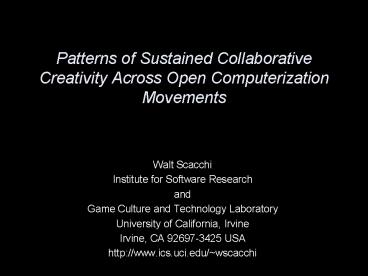Patterns of Sustained Collaborative Creativity Across Open Computerization Movements
Title:
Patterns of Sustained Collaborative Creativity Across Open Computerization Movements
Description:
Patterns of Sustained Collaborative Creativity Across Open Computerization Movements –
Number of Views:27
Avg rating:3.0/5.0
Title: Patterns of Sustained Collaborative Creativity Across Open Computerization Movements
1
Patterns of Sustained Collaborative Creativity
Across Open Computerization Movements
- Walt Scacchi
- Institute for Software Research
- and
- Game Culture and Technology Laboratory
- University of California, Irvine
- Irvine, CA 92697-3425 USA
- http//www.ics.uci.edu/wscacchi
2
Overview
- Three emerging Computerization Movements
- Open source software, computer games, and
scientific grid computing - CM intersections
- OSS-CG, OSS-SGC, CG-SGC, OSS-CG-SGC
- Observations and discussion
3
Computerization movements
- Social movement theory Blumer, Zald, Gerlach
- CM studies Kling and Iacono, Elliott and Scacchi
- Computing world dynamics Kling and Gerson,
Scacchi - Socio-technical interaction networks Kling,
McKim, Lamb, Sawyer, Scacchi, et al.
4
Three emerging CMs
- Open source software
- Computer games
- Scientific grid computing (Cyberinfrastructure)
5
CM drivers
- Structural patterns
- Participants beliefs in action
- Organizational centers
- Collaborative work practices within innovation
processes that intersect or segment one another - Innovations add to, or redistribute access to,
computing or workplace resources - Innovation processes animate and provide emergent
force to computerization movements
6
Routine innovation processes as collaborative
creativity
- Development--inventing and discovering,
reinventing, and standardizing software
development - Use--acquiring software systems and skills, while
also tailoring of software system features to
support software system use - Maintenance--debugging, enhancing, restructuring
(refactoring), tuning, or migrating to new
versions of software systems being actively
maintained
7
Open Source Software
8
(No Transcript)
9
(No Transcript)
10
SourceForge Projects May 2006
11
Sample OSS DevelopmentGroup Work, Utretch 2006
12
FOSS Social Networking across projects
13
Google Summer of Code 2006
14
Computer Games
15
(No Transcript)
16
Csports.net Game Players, May 2006
17
(No Transcript)
18
(No Transcript)
19
(No Transcript)
20
Hot Rod PCs
21
(No Transcript)
22
(No Transcript)
23
(No Transcript)
24
Scientific Grid Computing (Cyberinfrastructure)
25
NSF Cyberinfrastructure May 2006
26
Scientific Grid Computing site sample, May 2006
27
OpenScienceGrid Web siteMay 2006
28
Intersecting CMs
- OSS and Computer Games
- If developing software is rewarding, and playing
games is fun, then developing game software
should be fun and rewarding. - Game modding is a primary venue for innovative
OSS game development - Game mods sell games, and help their developers
get jobs in the game industry. - --gt Likely to persist as a shared segment of both
the OSS and Computer Game worlds
29
SourceForge Software Map May 2006
30
Intersecting CMs
- OSS and Scientific Grid Computing
- Globus, the key middleware component for SGC, is
OSS - GC depends on
- Open grid service integration (OGSI)
- Open grid service architecture (OGSA)
- Globus standardization and open source
- To enable innovative configuration and
integration of virtual organizations from their
open application service interfaces - --gt Likely to be assimilated within Scientific
Grid Computing world
31
(No Transcript)
32
Intersecting CMs
- Computer Games and Cyberinfrastructure
- Game grids for massively multiplayer online games
(MMOG) - New Sony PlayStation 3 (Fall 2006) to utilize
grid services - Enables new class of innovative game play
experiences and virtual (game-based) economies
(i.e., games EBay) for game developers to
create - Represents new, innovative venue for government
RD (and Education) investments - --gt Likely to be assimilated into Computer Game
world
33
CERN Quantum Game
34
(No Transcript)
35
Intersecting CMs
- OSS, Computer Games, Cyberinfrastructure
- Smallest, least-populated sub-world
- Linking three independent CMs/subworlds
- Very few projects, modest social network, unable
to instigate network externalities - Denotes an interesting boundary case, as is
potential to stimulate or support innovative apps
- --gt May be the social locale giving rise to the
Web 3.0
36
(No Transcript)
37
Observations
- Prior studies treated CMs as independent, rather
than segmented, polycentric, networked,
heterogeneous, and intersecting - Some intersecting CMs are assimilated into the
larger/dominant CM - Other intersecting CMs have the potential to
emerge as their own sub-world - Other intersections may be so fragile and
marginal as to merit study on their own.
38
Observations
- How open a CM is determined by the innovation
frontier it supports or creates - The recurring emergence of creative collaborative
work is inherent when CMs intersect one another.
39
Acknowledgements
- Mark Ackerman (UMichigan), Margaret Elliott
(ISR), Les Gasser (UIUC), Chris Jensen (ISR),
Robert Nideffer (UCI Game Lab), John Noll (Santa
Clara U), Celia Pearce (ISR), also others at ISR
and UCI Game Lab. - Research grants from the National Science
Foundation (no endorsement implied) 0083075,
0205679, 0205724, 0350754, and 0534771. - Discovery Science Center, Santa Ana, CA
- UC Humanities Research Institute
- Digital Industry Promotion, Daegu, Korea
- California Institute of Telecommunications and
Information Technology (CalIT2) - Creative Kingdoms Inc.































